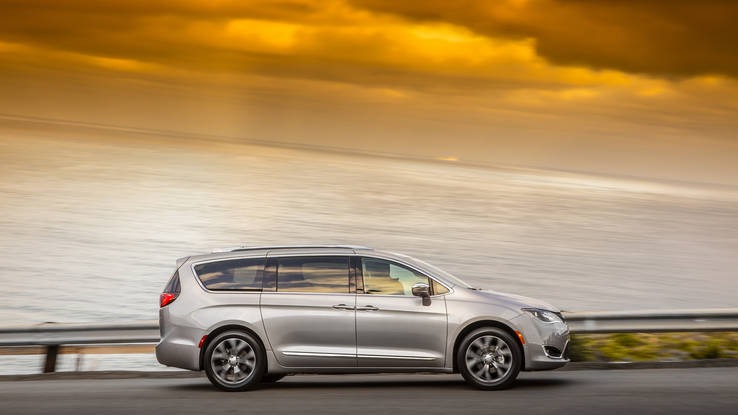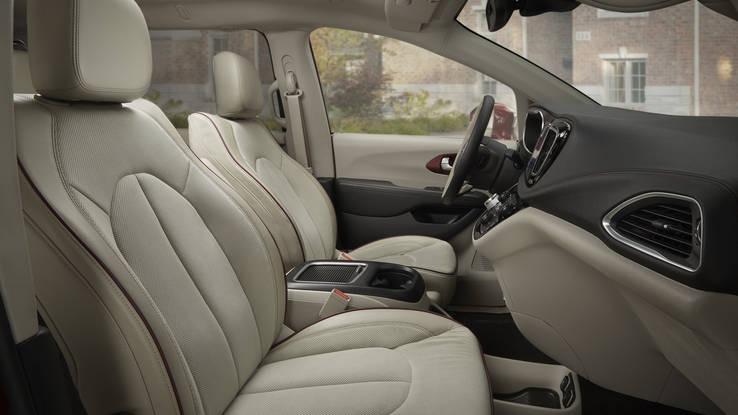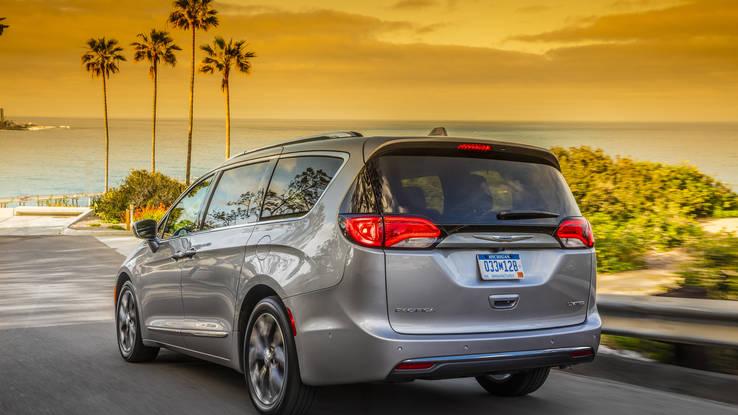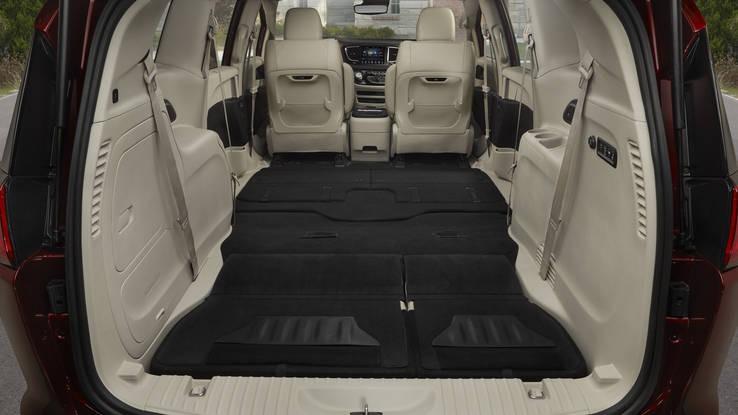Flexibility and, for the first time, excellent road manners make the newest Chrysler minivan an easy companion
Do you always choose the best tool for a given job, or do you fudge it a bit, reaching for a nearby pair of Vice-Grips because the 6-point sockets are all the way out in the garage?
If it’s the former and you have a family, you probably also drive a minivan.
“It’s a better tool for the family,” explains Tim Kuniskis, FCA’s head of passenger cars. Having owned a minivan — along with several so-called substitutes — we wholeheartedly agree. And the new Chrysler Pacifica is, at least for now, the best of these “better tools.”

There are only so many ways to style a van, but the Pacifica at least looks fresh and texturally interesting.
The 2017 Pacifica minivan replaces both the Town & Country and, eventually, the venerable Dodge Grand Caravan, with a recycled Chrysler nameplate; the goal is to put some emotional distance between it and the brand’s recent nondescript, sensible people movers. Yes, the change is also part marketing gimmick — there are only so many ways to configure a box, after all — but there’s also reason to emphasize the Pacifica’s clean-sheet design and engineering. This isn’t a refresh; it’s the next generation of minivans from the company that invented the segment. That segment may have shrunk in the past decade, but Chrysler’s not about to let go of its substantial piece of the remaining pie.
Nor should it have to. The 2017 Pacifica is as elegant an interpretation of the van as anything yet imagined. Designers incorporated the new winglike corporate fascia, blending flowing curves into the sculpted sides and around the rear, nary a crease or sharp line in sight. Even the sliding-door “slash,” an attribute stylists claimed screamed “minivan” to focus-group participants, vanishes in the black side window trim — go ahead and search for it; it’s nearly invisible. The forward kick of the rear pillar looks like an integrated “A-Team” van wing, again breaking up the expanse of side acreage. It’s still a minivan, but not one that requires apologies.
Exterior styling doesn’t sell minivans, though, and the Pacifica’s interior will force anti-vanners to scramble for objections. Our time was spent in well-equipped Limited models, but many of the elegant design features will translate to base Pacificas — beveled, brushed-metal vent rings, a “brush-stroke” sculpted dash and a control center tipped horizontally and canted toward the driver all further the impression of an upscale crossover versus “mom’s taxi,” though a few months of juice boxes and soccer cleats will temper stylists’ best efforts (a fate those upscale crossovers also face).
Storage options abound throughout the Pacifica — dash bins, console bins, door pockets, cubbies and pockets. The familiar Stow ‘n Go bins are available under the mats when the seats are in use, while the procedure for making the second-row seats vanish has been rendered absurdly simple: flip the floor panel up, pull a lever, press the seat into the well with a click and drop the panel down. Need to load passengers in the third row, but have a LATCH car seat strapped in the second row? No problem — the seat now tips and slides forward for access without yanking the child safety seat. The third row folds and tumbles with a couple yanks (unless you have the slower power-folding seats — basically superfluous here), easy enough that we converted our van from 8-passenger school bus to empty cargo van in under 60 seconds — again, without juice boxes and cleats to move.
Adding to the convenience features, the power-sliding doors and power liftgate are now offered with hands-free operation (a foot wiggle does the job), while a three-pane panoramic moonroof brightens up the former penalty-box third row.

2017 Chrysler Pacifica minivan front seats and dash.
Available on top Limited models, Vac ‘n Go is Chrysler’s interpretation of Honda’s pioneering in-car vacuum. Improvements include a location more easily accessed by the second row (where focus groups showed most of the mess usually is) and a 14-foot that hose that retracts rather than needing to be coiled for storage. There’s even an extra 14-foot hose included so you can vacuum your neighbor’s car or chase the dog around the yard.
Tasked with moving all these features around is Chrysler’s now-familiar Pentastar 3.6-liter V6 engine coupled to a nine-speed automatic; yes, this is the same basic powertrain about which we’ve had mixed feelings in the 200 and Cherokee, but there’s reason for optimism here — more on that in a moment. Independent rear suspension finds its way beneath a Chrysler van for the first time; combined with NVH improvements and standard Active Noise Cancellation, the Pacifica is a quantum leap in refinement over previous Chrysler minivans.
Much has been made of the Pacifica plug-in hybrid; yes, it is coming, but no, we didn’t get to drive or play with one. Expect an Atkinson-cycle version of the V6 coupled with a dual-motor drive system on the hybrid, returning up to 80 MPGe. As a plug-in, the Pacifica hybrid will charge in 2 hours on a level-2 charger and deliver up to 30 miles of pure EV driving. Unfortunately, Stow ‘n Go will be gone, the space taken up by batteries. We’ll have more on the Pacifica hybrid this fall when we get a chance behind the wheel.

The Pacifica’s back glass is all in the tailgate, but black sail panels give an impression of wraparound glass.
How does it drive?
Owners of current Town & Country minivans are in for a shock. The new van is vastly stiffer than the outgoing model, with flat, secure roadholding well past the limits to which most would press a family hauler. Similarly, squat on acceleration and brake dive are both minimal, leading to, dare we say, “fun” behind the wheel previously unheard of in a Chrysler minivan. Credit the new chassis which was designed from the Stow ‘n Go storage wells outward, along with its independent rear suspension — this is a quiet, comfortable platform whether winding through subdivisions or cruising long distances on interstate highways.
As we alluded to earlier, Chrysler has engineered most of the weirdness out of its 3.6-liter V6/nine-speed automatic combo, to the point where the Pacifica feels significantly quicker than its rivals, even if it can’t quite match the smoothness of an Odyssey V6. We’re still not sold on the rotary-shifter knob, which still feels unnatural, but once D is located there’s ample power even for mountain passes with four people and their stuff on board. In mixed freeway/in-town driving we averaged just over 25 mpg, an excellent figure for the class, helped by a 250-lb weight savings over the outgoing Town & Country.
Driving a minivan isn’t so much about vehicle dynamics, though — it’s about safe, convenient family transport, and in that respect the Pacifica benefits from recent tech advances. Surround-view cameras give a bird’s-eye view when backing or maneuvering; the available UConnect Theater rear entertainment system includes built-in game apps, so the kids don’t have to watch Ice Age for the 63rd time. Most importantly, though, the Pacifica has acres of usable space and storage: The utility, and ease of accessing it, is almost addictive.

Thanks to Stow ‘n Go, your Pacifica can go from minivan to this in about 60 seconds.
Do I want one?
The most important success metric for a tool is how well it performs the function for which it’s designed. Judged by that criterion, the Chrysler Pacifica is the best multi-purpose people mover in the world, at least for the moment (Honda has a new Odyssey in the works, and Toyota will likely follow with a refreshed Sienna).
But it’s a minivan. Can you handle driving a minivan?
If you can at least handle test-driving one, head over to a Chrysler dealership and prepare to embrace your inner soccer mom.




























